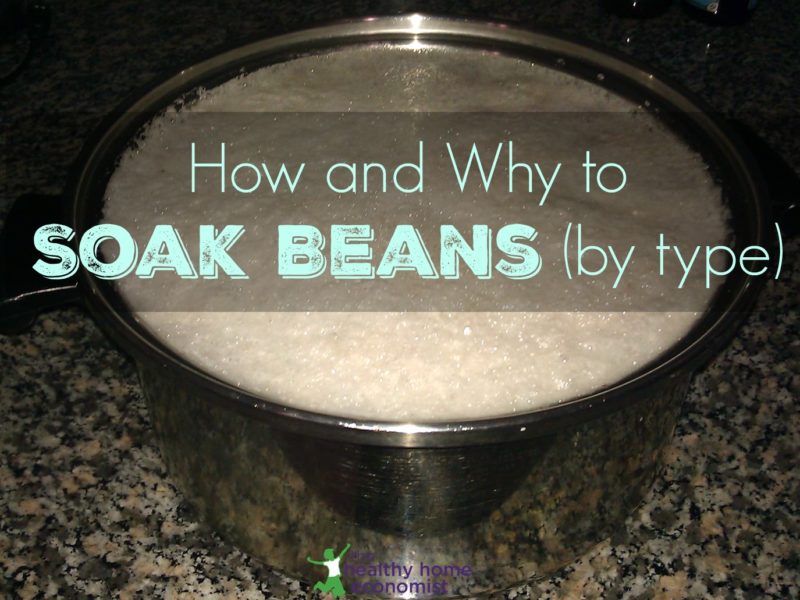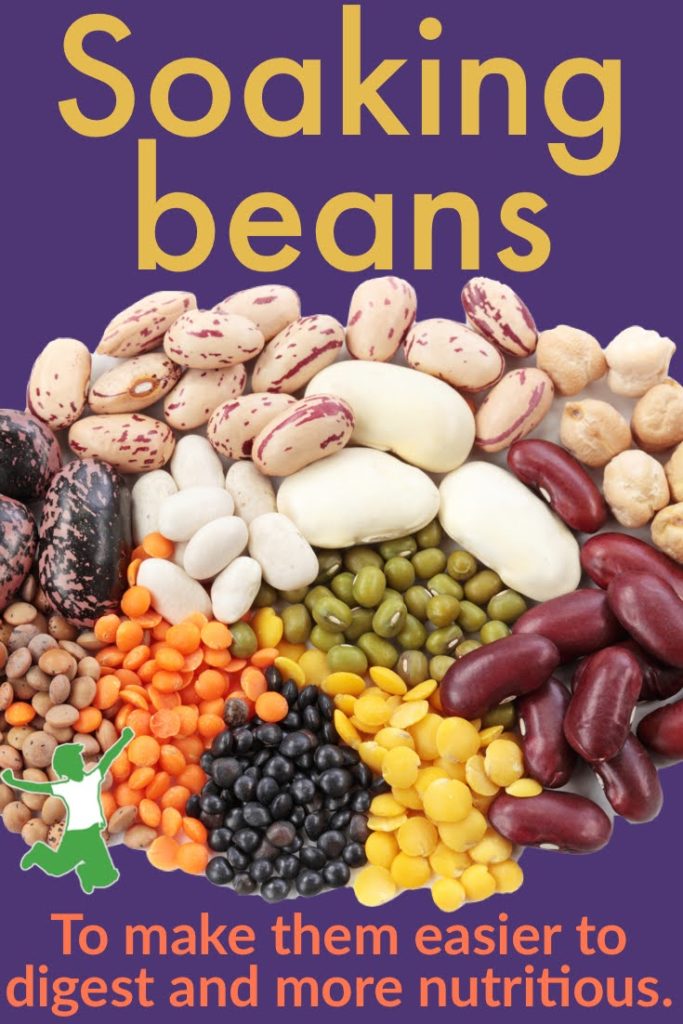Table of Contents[Hide][Show]
The simple overnight process of how to soak beans (by type) will help to eliminate gas and intestinal issues so you can enjoy eating these nutritious plant foods again!

I went on a bean soaking binge this past weekend, and the amount of scum that came to the top of the large pot of soaking kidney beans was so huge, I thought it deserved its own blog post. Soaking beans for many hours before cooking them produces a lot of scum which is course, is rinsed and drained away when the soaking is complete.
What is all that scum anyway? Anti-nutrients, that’s what! And those anti-nutrients such as phytic acid, lectins, and enzyme inhibitors are going to be in your gut causing you gas, heartburn, reflux, and whatever other digestive ills beset you when you eat something that isn’t particularly digestible unless you soak your beans before cooking them.
Traditional cultures took great care to prepare their legumes with a long soak before cooking to enhance digestibility and nutrient absorption.
I love Mexican food but really try to avoid Mexican restaurants for this reason .. they don’t soak their beans before cooking them!
After a meal at a Mexican restaurant, I will typically feel very bloated. Eating the same meal prepared at home where I soaked the beans properly before cooking results in no digestive upset whatsoever.
Take the Soaked Beans Challenge!
If you think unsoaked beans don’t cause you any trouble .. take this challenge. Soak beans next time before cooking and notice the difference in your stomach after eating.
You may think that the unsoaked beans don’t cause you any trouble, but you just may find that soaked beans are infinitely more filling and that you eat less and enjoy the meal more as a result!
Traditional peoples were very wise in the preparation of their foods. They not only selected nutritious foods but they prepared them for maximum digestibility and nutrition.
What good is eating nutritious legumes if the body is so whacked by the anti-nutrients that it can’t very easily extract and digest the nutrition?
So, the next time you make your beans, make sure you soak them first!
I soak large pots of various types of beans every month or so and then cook them – freezing for easy, quick meals when beans are required like homemade chili.
**If you absolutely do not have time to do this, at least buy pre-soaked legumes and beans packed in glass jars. Your digestion will thank you!
How To Prepare Beans by Soaking (video tutorial)
If you’ve never soaked beans before, it’s so easy. It’s a very similar process to soaking nuts. The method also mimics the wisdom of traditional societies that soaked seeds.
See this short video below that demonstrates the simple process.
Kidney shaped beans
For kidney shaped beans and dried/split peas, put a pinch of baking soda and enough water to cover in a large pot and soak uncovered for 12-24 hours. Drain, rinse and cook as usual.
Examples of kidney-shaped beans include:
- Red kidney beans
- White kidney beans (cannellini beans)
- Pinto beans
- Anasazi beans
- Black-eyed beans (black-eyed peas)
- Great Northern beans
- Lima beans
Non-kidney shaped beans (and other legumes)
For more oval-shaped beans and other legumes, soak for 12-24 hours in filtered water to cover plus 1 tablespoon of cider vinegar or lemon juice for every cup of dried beans/legumes used.
A homemade apple cider vinegar recipe or store-bought are both fine (make sure the ACV is packed in glass). Liquid whey from yogurt, kefir, or clabbered milk may also be used. Drain, rinse, and cook as usual.
Examples of non-kidney shaped beans include:
- Black beans (turtle beans)
- Navy beans
- Fava beans
- Adzuki beans
- Chickpeas
- Lentils
For maximum digestibility, it is best to rinse and refresh the filtered water and baking soda or the acidic medium once or twice during the soaking period. If you forget, no worries.
I try to always soak beans for the full 24 hours instead of just overnight. Sometimes if I get busy, I might even soak them 36 hours, but this is risky as they can get moldy sometimes if you go over 24 hours. Best to stay between 12-24 hours particularly during summer months.
How to Cook Beans After Soaking
After soaking, be sure to thoroughly drain and rinse the beans until all the scum is washed away. Then, complete the process by doing the following.
- Fill the pot of rinsed pre-soaked beans with fresh filtered water, bring to a boil, and skim away any additional foam that may come to the top at the start of the boil.
- Turn down the heat to a simmer, add 4 crushed garlic cloves, and cook until the beans are soft (about 4 hours).
- Drain beans and add to your favorite dish or let cool and freeze in large freezer bags for quick meals at a later date!
You won’t be needing over-the-counter gas meds after preparing beans the traditional way!
Should You Use the Soaking or Cooking Water?
Some alternative cooking circles advocate using the soaking or bean cooking water. Unfortunately, neither of these practices is traditional.
Using the cooked bean water or aquafaba is actually a dangerous practice. See the linked article for reasons to avoid this modern food especially during pregnancy!
Other Types of Legumes
This article plus video on soaking lentils provide additional information specifically for this legume. Because they are soaked exactly the same as all non-kidney shaped beans, it is helpful for visual learners.
Lentils were the favorite of nutritional pioneer Dr. Weston A. Price due to their very high potassium content.
Recipes Using Pre-soaked Beans and Legumes
Here are some recipes to try using soaked beans and other legumes to entice you!









Has anyone ever created “instant beans” by dehydrating the ones they have cooked for long term storage or quick cooking later?
I’m about to try that. I’ve done it with brown rice & it comes out great. Add a little boiling water & it reconstitutes in a few minutes.
I want to make some dehydrated homemade soup & stew mixes using the veggies from my garden, but would like to include rice & beans as well. Dried pasta is easy enough to add as well, so with the beans, the possibilities would be endless!
I prepared a large batch of black beans tonight. I soaked for about 22 hours. I had read on a different website that buttermilk is also a good acidic medium so that is what I used. My beans produced very little “scum” or foam on top. I rinsed and filled pot with purified water & put on the stove top to start a boil. When the boil started, tons of foam came up to the top!! I scooped off as much as I could.
Maybe next time I will try ACV as a medium to see if it works better.
Here’s something for everyone to think about. I read on another website a tip about cooking beans in the oven instead of on the stove top which is supposed to drastically reduce cooking time. Now this person was saying you don’t have to soak the beans with this method & was cooking in 1.5 hours with no soaking. He obviously did not see the value of soaking, but the method works great. I decided to try it with soaking. So I soaked the 22 hours, started the boil on the stove, removed the additional scum that came to the top & then placed my dutch oven in the oven at 250 degrees.
My full pot of black beans were done to perfection in just 65 minutes! The time on the package for black beans said 1 1/2 – 2 hours after soaking. So I cooked them in about 1/2 the time!
I was so happy because they were so perfect. I have always had a problem ending up with mushy beans, but cooking them in the oven produced perfectly cooked beans, and in such little cooking time!
Am I correct in thinking that the less cooking time the more nutrients the beans retain? If so this oven method is great for a more nutritious end product!
I can’t say if nutrients would survive longer… but I have always read that beans should be cooked at low temperatures for a very long time for them to be digestible.
Sarah, or anyone who remembers…I’ve been trying to find the video where you add what I think was kombu to a pot. I thought maybe it was for your beans… How do you use your kombu in cooking and what does it add?
ok, this post made me feel sooo good..because…i hate to say this: but if i left my beans soaking for more than 12 hours i would throw them away because i worried they would go bad! (can you tell i’m new to cooking with whole foods??) so it’s WONDERFUL to know that soaking 24-36 hours is actually better! by the way, can you soak beans and THEN freeze them without cooking? sometimes i fully intend to throw them in the crockpot but then something distracts me and i forget to..so can they be frozen post-soaking, pre-cooking?
Well, we’ve been following GAPS, so this past week I soaked both limas and split red lentils overnight, then rinsed and covered with water and whey and let ferment for 5 days (limas and lentils separately). I’ve been cooking them for hours (and hours, really) and they are HARD. Pre-GAPS we soaked overnight in water and they cooked happily. I am very curious that others have soaked with whey and/or lemon juice and have not had this problem. ????
Hi All,
Being that Native Americans added ashes(an alkali) to their corn in preparing the corn for eating in order to make the corn healthy to eat as a primary staple(Niacin being made available by the processing), what about adding Baking Powder to grains, whether Oatmeal, Kamut/Wheat/Spelt, Brown Rice, and so forth….
Does that improve the quality for human nutrition as compared to without, especially in grain preparations that aren’t yeast cultured?
Btw, it seems I usually do best healthwise with whole grain products, than with ‘white/refined/fractionated’ grain products, as long as they’ve been adequately prepared with grinding, cooking, and culturing, as appropriate. ‘Refined whites’ tend to reduce my ‘libodo’ in a way that doesn’t seem healthy. If refined whites are substantial in ones diet, one must be sure to get adequate nutrition from animal and/or bean products, and leafy greens/vegetables, in order for the isolated starch to be a healthy part of the diet.
Hi Sarah and everyone,
What about that bean broth that’s leftover? I’m so tempted to put that back in my chili after cooking those beans or perhaps freezing it. I can’t find any info online about if it’s nutritious or not – keep it or throw it out? Thanks!
I know this is an old post but do you know about boiling beans to remove lectins? I soak my beans for 24 hours in water with whey but I usually just thrown them in to a crock pot with a meaty bone, stock, and water afterwards. I recently found out that it should be boiled for 10 minutes before slow cooking. Have you ever heard this? Would slow cooking overnight destroy lectins too?